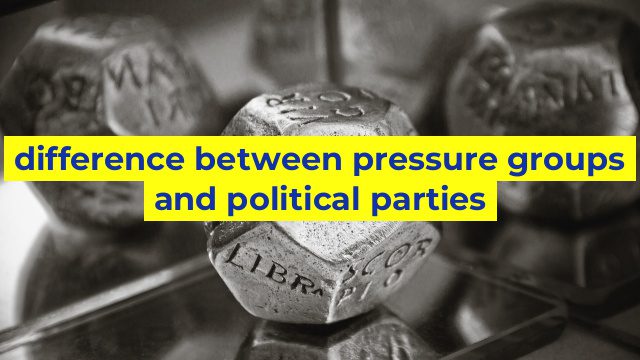The Difference Between Pressure Groups and Political Parties
Introduction
Pressure groups and political parties are two different terms that come up when talking about political matters. However, many people get confused between these two terms, and they may use them interchangeably. While both of these groups play significant roles in influencing political decisions, they have entirely different characteristics that set them apart.
Definition of Pressure Groups
Pressure groups are organizations that seek to influence political decisions and policies by putting pressure on the government or opposing groups. The main objective of pressure groups is to use their influence to sway the government to adopt policies or decisions that are in their favor. Pressure groups are also known as interest groups, advocacy groups, or lobbying groups.
Types of Pressure Groups
There are different types of pressure groups, such as economic, sectional, and promotional groups. Economic pressure groups focus on economic issues, such as labor unions and business associations. Sectional pressure groups represent specific sections of society, such as ethnic groups or trade unions. Promotional pressure groups advocate for social or environmental issues, such as animal rights, environmental protection, or gender issues.
Definition of Political Parties
A political party is an organized group of people who come together with the same political ideologies, beliefs, and preferences to contest elections and run the government. Political parties aim to attain political power through elections and to control the policies of the government once in power.
Types of Political Parties
There are different types of political parties, such as leftist, rightist, centrist, and populist parties. Leftist parties are those that advocate for a socialist or communist approach towards governance. Rightist parties support conservative or capitalist policies. Centrist parties try to find a balance between left and right-wing ideologies, while populist parties focus on appealing to the masses through their rhetoric and policies.
Differences Between Pressure Groups and Political Parties
The fundamental difference between pressure groups and political parties lies in their objectives and strategies. Political parties aim to gain control of the government and influence policies through electoral processes, while pressure groups focus on influencing policy decisions by putting pressure on the government through lobbying, protests, and advocacy. Political parties are also more organized and have a formal structure, while pressure groups are often informal, and their membership may not be substantial.
Conclusion
In summary, pressure groups and political parties have different approaches towards political influence. While political parties aim to control policy decisions through electoral contests, pressure groups use other means such as advocacy and lobbying to influence decision-making. Understanding the difference between these two groups is crucial in understanding how political decisions are made and how they impact society.
Table difference between pressure groups and political parties
| Pressure Groups | Political Parties |
|---|---|
| Comprise of individuals or organizations that seek to influence government policies and decisions without contesting an election | Comprise of individuals or a group of individuals seeking to contest an election and gain institutional power to implement policies and decisions |
| Focuses on a single issue or a set of related issues | Focuses on a broad range of issues and takes a position on various policies |
| Rely on non-electoral methods such as lobbying, petitions, protests, and awareness campaigns to influence policymakers | Rely on electoral methods such as canvassing, election rallies, and advertisements to garner votes and win elections |
| Do not have formal membership and work on a voluntary basis | Have a formal membership structure and operate with a hierarchical structure |
| Do not have a fixed political ideology and can support policies of multiple political parties | Have a fixed political ideology and support policies that align with their ideology |
